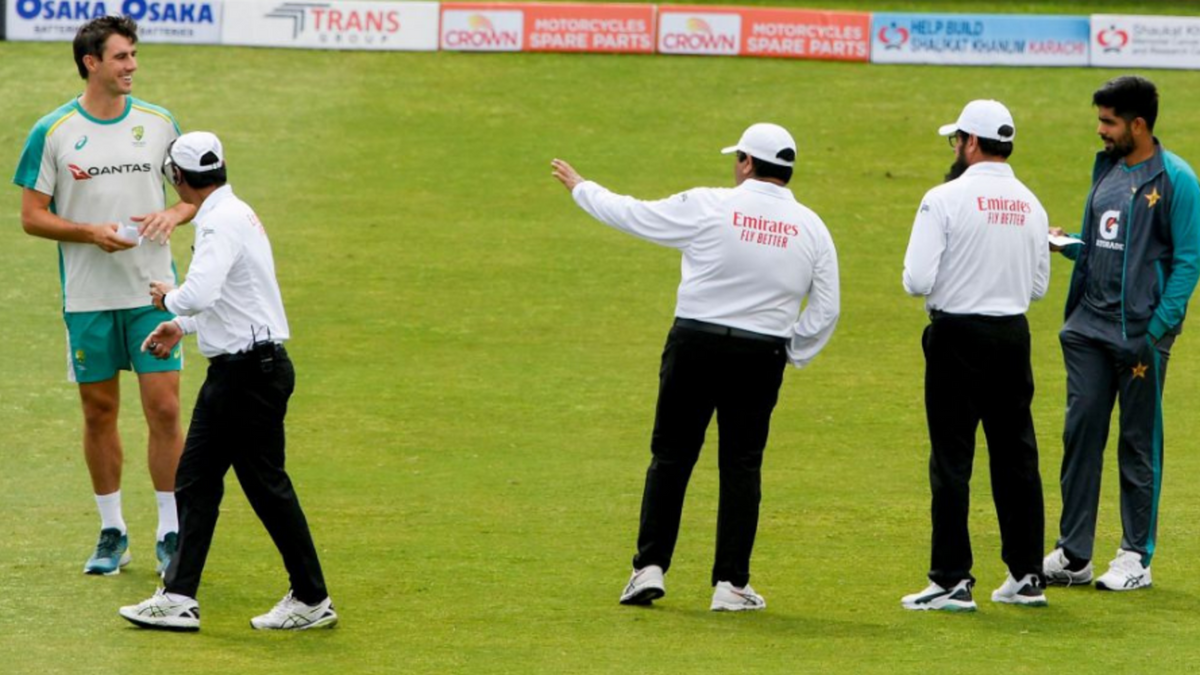
After an extraordinarily long wait, Australia returned to Pakistan to play Test cricket. The pitch at Rawalpindi, though, took the sheen off the occasion and ensured that the surface, rather than the cricket, took centre-stage.
During the first Test, 1,187 runs were scored, with only 14 wickets falling across the five days. Australia were able to account for only four Pakistan batters in 239 overs – one via a run out – casting further light on what the track had to offer for the bowlers. The hosts bagged all 10 Australian wickets but took 140.1 overs to do so, meaning that neither side had a chance to force a result. Unsurprisingly, the nature of the pitch dominated discussions after the contest. The ICC stepped in and handed out a ‘Below Average’ rating.
For those unaware, a ratings system (for the pitch and the outfield) has been created by the ICC, wherein the Match Referee can place the surface into one of six categories – ‘Very Good’, ‘Good’, ‘Average’, ‘Below Average’, ‘Poor’ and ‘Unfit’. If a pitch is given an Average rating or above, they don’t accrue any demerit points. However, if a ‘Below Average’, ‘Poor’ or ‘Unfit’ rating is given out, the venue receives demerit points.
A ‘Below Average’ rating attributes to one demerit point, a ‘Poor’ rating amounts to three demerit points and an Unfit rating leads to five demerit points. If five demerit points are accumulated over a five-year span for any venue, that venue is banned from hosting international cricket for 12 months. In principle, this seems a step in the right direction, considering it prevents countries from preparing surfaces that are too skewed in their favour.
But there is another spin to the story. It doesn’t happen often that a demerit point is handed out to venues. In the past few years, there have not been many such instances.
According to the ICC website, only two pitches has been given a ‘Below Average’ rating since the start of 2021. The first Sri Lanka-Bangladesh Test at Pallekele and the recent drab draw at Rawalpindi.
Pitches are rated ‘Below Average’ when “either very little carry and/or bounce and/or more than occasional seam movement, or occasional variable (but not excessive or dangerous) bounce and/or occasional variable carry. If a pitch demonstrates these features, then the pitch cannot be rated in a higher category regardless of the amount of turn the pitch displays at any stage of the match.”
The same document also provides a definition of a ‘Poor’ pitch, stating – “A Poor pitch is one that does not allow an even contest between bat and ball, either by favouring the batters too much, and not giving the bowlers (seam and spin) from either team sufficient opportunity to take wickets, or by favouring the bowlers too much (seam or spin), and not giving the batters from either team the opportunity to make runs.”
As things stand, the demerit points system allows a venue to have five ‘Below Average’ pitches on the trot before they are banned from hosting international cricket. Just as an example, Rawalpindi can produce four more lifeless tracks before they are reprimanded. It is unlikely for teams (especially nations with more stadiums) to host more than one Test at a particular venue in a single year. So, even if a venue averages one demerit point per year, it can keep hosting Test cricket for five years.
The complications arise when a pitch is rated ‘Poor’ because three demerit points are meted out. Even in such a scenario, sides might be tempted to play to their strengths twice in succession, considering they will only get barred from hosting international cricket after two such offences.
Thus, a case can be made that the system of accumulation of demerit points can be a little stricter. Five demerit points – that too across a five-year period – doesn’t provide enough jeopardy. For example, if an outfit needs just a victory/draw to qualify for the ICC World Test Championship final, there is not enough of a deterrent for the venue to prepare a skewed surface, knowing that they will not get reprimanded immediately. Moreover, if such transgressions are an aberration, they need to be dealt with in that manner as well.
Additionally, there is an enormous amount of subjectivity involved in terming these pitches ‘Below Average’ and ‘Poor’. While that debate is better left for another day, it is an area where pitch curators can get away with preparing substandard pitches.
If the rules remain the same, there could be a situation where a nation begins exploiting it – as Ramiz Raja hinted that Pakistan recently did themselves. And that, considering how Test cricket remains the pinnacle of our sport, would be an enormous dampener.








